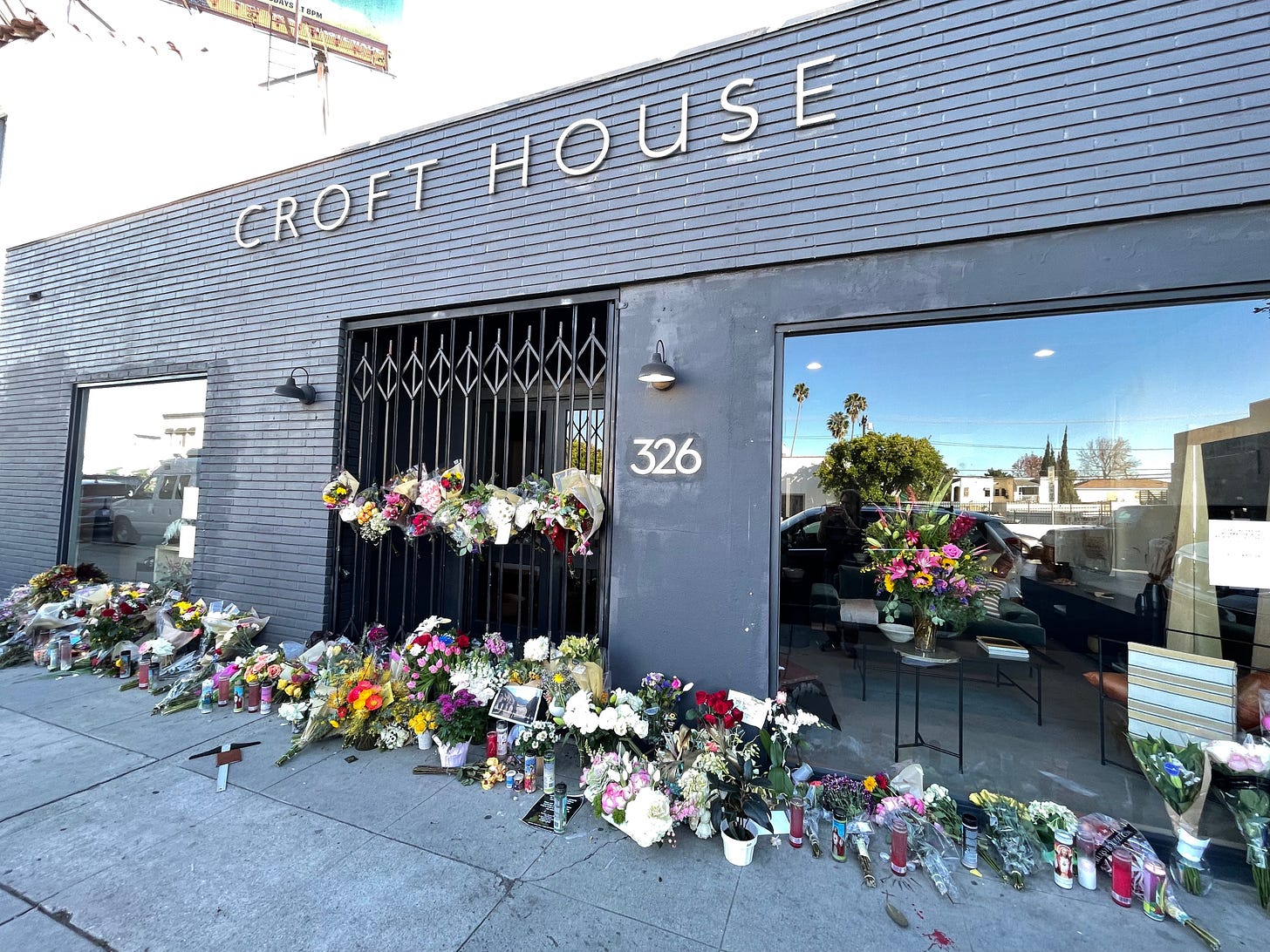Los Angeles in the New Age of Violence

I never knew her in life. She exists for me through others, in evidence of the ways her death drove them.
― James Ellroy, The Black Dahlia
Los Angeles has a tricky way of being incomprehensibly large and maddeningly small. It’s always been a fractious assemblage of enclaves, swamping an enormous basin, several mountain ranges, and a few valleys, inhabited by millions apt to deny that they live in a city at all. With enough cash, you can still tuck yourself into a corner of the megalopolis and be as pinched as a parochial townie, oblivious to the metropolitan whole. Planners are always trying to prod a recalcitrant L.A. toward conventional urbanity. But avoidance, abetted by sclerotic freeways, remains the default position.
Of course, it is a big city—now more than two centuries old, diverse, corrupt, intoxicating, and menacing. L.A.’s sinister side regularly makes itself known, even in manicured parts of town. Thanks to Raymond Chandler and Hollywood, everybody knows this is not only a place of dreams but terrors. Alongside palm trees and fakery, it’s part of a relentlessly exported image. No community has a monopoly on murder. It’s part of the grim routine here as it is anyplace, only the backdrop is different. It beguiles, no matter how bloody it gets.
And it is a bloody season in Los Angeles, as it is in other great American cities. For the first time in decades, the murder rate is up, and scary tales are being transmitted far and wide, making a place that sits on the edge of everything that much edgier. Nearly 400 people were killed in L.A. in 2021, the most of any year since 2007. The spike is especially jarring because, for years, things seemed to be moving in a reassuringly Scandinavian direction. As recently as 2019, officials were celebrating the 10th straight year of falling homicides.
Here’s where well-meaning caveats are voiced. Such as L.A. may be getting incrementally more deadly, but it remains safer than many U.S. cities. Or: If you think this is scary, you weren’t here for the crack wars of the 1980s. The various causes of this spike in violent felonies—pandemic disruptions, more guns, an explosion of homelessness, the (take your pick) overhaul or collapse of criminal justice —are much debated. Theorizing doesn’t help the victims or tamp down a growing sentiment that things are spiraling out of control.
If you were raised in an even more dangerous California, this gathering storm comes with a prickle of déjà vu. Lurching between sunny optimism and dark paranoia is as familiar as a tremor. That magical sense that anything can happen is easily flipped, for unspeakable things are just as possible. Everyday murder is a domestic affair between people who know one another, but Southern Californians, strangers in a sea of strangers, live in dread of arbitrary savagery— the intruder who scales the compound fence. After all, this is a place famed not just for laid-back optimism (it’s all good), but the Manson Family (no, it’s not). A true Angeleno becomes adept at walking the tightrope between fantasy and nightmare without breaking a smile.
Recently, the old horrors —shrugged off, shunted far south of the 10 freeway—have resurfaced in unexpected places. On the morning of January 13, Sandra Shells, a 70-year-old nurse, died after being assaulted while waiting for the bus by Union Station in downtown Los Angeles. A few hours later, Brianna Kupfer, a 24-year-old UCLA graduate student, was fatally stabbed while working at a furniture store on the outskirts of affluent Hancock Park, nine miles distant. In both cases, the alleged killers were transient men with long criminal histories. Homelessness, in the form of proliferating street encampments (where the homeless themselves are routinely victimized), is already a point of intense anxiety. The randomness of these attacks — and a rising fear that they could have happened to anybody, anywhere— further agitated a jumpy public.
Shells and Kupfer were not typical L.A. murder victims. As in previous waves of violence, most of the fallen are young Black and Latino men from the city’s poorest neighborhoods, caught in an interminable cycle of gang brutality. In 2021, more than 70 percent of all murders took place in the city’s South and Central police districts; only about 11 percent were recorded in the more affluent West bureau, where Kupfer, who was white, was slain. Her death drew national attention and quickly became mired in an endless wrangle over race, class, justice, and geography. She was a good kid, from the right side of the town, a kid you could know. But what about the other kids from other parts of town, sacrificed in huge numbers, that nobody notices? And so on.
The tragedy, of course, is that all of this is true. Kupfer was a blameless victim of a senseless atrocity. She was a daughter of the L.A. I know best, and our lives intersected in all kinds of ways. That such a thing could happen to her, or anybody’s beloved child is grotesque. Wherever you live, her loss should feel wrenching and personal. The deaths of Tioni Theus, 16, whose crumpled body was found on an offramp of the 110 freeway in South L.A. on January 9, or Valentina Orellana-Peralta, 14, killed by a stray bullet while trying on quinceañera dresses at Burlington Coat Factory in North Hollywood on December 22, are also affronts to decency. To those left behind, it makes no difference whether somebody is perfectly representative of a larger pathology or not. There is only bottomless grief.
It’s only natural, in this stew of villages, to count degrees of separation between yourself and the victim. There are other victims in other villages, taken by crimes that are rarely publicized. These nameless are too numerous to count, let alone hold candlelight vigils for. Given the ongoing toll of violence—machete attacks in homeless encampments, headless bodies found in the mountains, innocents caught in the crossfire, the not-so-innocent whose lives are wasted—it’s surprising we still have a capacity, however fleeting, to be appalled.
If there is a prevailing religion of L.A., it is the Cult of the Good Life, an orthodoxy that has proven remarkably durable despite a gruesome history. The mansion is invaded in the dead of night, or bodies are found in a culvert, and the terrorized rush off to invest in guard dogs, weapons, and high-tech security systems. Then the nightmare fades, and a hazy numbness settles back in, low and thick, over the sprawling basin. Outsiders have a tendency to misread the blank pleasantness of Angelenos as stupidity or phoniness, but it speaks to an abiding faith in performance: If we act nice, perhaps things will actually be nice. Scared people have a weakness for delusion. And Los Angeles may just be the most hopeful, frightened place on earth.
When things have gotten scary in the past, there has been a reaction — against a perceived moral loosening, liberal equivocation, and chaos in the streets. It’s too soon to say if that will happen again, but if history is any indication, the results of such a backlash will not be pretty. Americans, even other Californians, tend to loathe Los Angeles, but they ought to appreciate that it perfected the national sport of pitching between extremes.
Other cities are encapsulated by their landmarks, we grasp that they have centers and endpoints. Los Angeles is too unwieldy to be contained by mere geography, so it gets described conceptually. It’s that cliché of heedless extravagance and empty people, a hard beauty, an ugly fraud, a sinkhole of depravity, the place where ghastly crime is processed into legend. More than 18 million people go about more or less ordinary lives in its uncaring vastness, but the conventional wisdom is that nobody would choose to die in it. Yet they do, every day. In shared horror of death, and rage at its blind cruelty, there may be something, out here on the edge, that knits us together at last.
